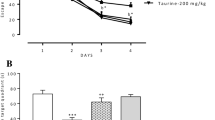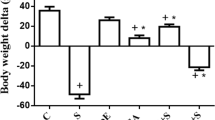Abstract
It has been shown that emotional stress may induce oxidative damage, and considerably change the balance between pro-oxidant and antioxidant factors in the brain. The aim of this study was to verify the effect of repeated restraint stress (RRS; 1 h/day during 40 days) on several parameters of oxidative stress in the hippocampus of adult Wistar rats. We evaluated the lipid peroxide levels (assessed by TBARS levels), the production of free radicals (evaluated by the DCF test), the total radical-trapping potential (TRAP) and the total antioxidant reactivity (TAR) levels, and antioxidant enzyme activities (SOD, GPx and CAT) in hippocampus of rats. The results showed that RRS induced an increase in TBARS levels and in GPx activity, while TAR was reduced. We concluded that RRS induces oxidative stress in the rat hippocampus, and that these alterations may contribute to the deleterious effects observed after prolonged stress.
Similar content being viewed by others
References
L. McIntosh R. Sapolsky (1996) ArticleTitleGlucocorticoids increase the accumulation of reactive oxygen species and enhance adriamycin-induce toxicity in neuronal culture Exp. Neurol. 141 201–206 Occurrence Handle10.1006/exnr.1996.0154
C. Cochrane (1991) ArticleTitleMechanisms of oxidant injury of cells Mol. Aspects Med. 12 137–147 Occurrence Handle10.1016/0098-2997(91)90009-B
J. Liu X. Wang A. Mori (1994) ArticleTitleImmobilization stress-induced antioxidant defense changes in rat plasma: effect of treatment with reduced glutathione Int. J. Biochem. 26 511–517 Occurrence Handle10.1016/0020-711X(94)90008-6
L. Manoli G. D. Gamaro P. P. Silveira C. Dalmaz (2000) ArticleTitleEffect of chronic variate stress on thiobarbituric-acid reactive species and on total radical-trapping potential in distinct regions of rat brain Neurochem. Res. 25 915–921 Occurrence Handle10.1023/A:1007592022575
A. S. Sosnovsky A. V. Kozlov (1992) ArticleTitleIncreased lipid peroxidation in the rat hypothalamus after short-term emotional stress Biull. Eksp. Biol. Med. 113 486–488 Occurrence Handle10.1007/BF00840930
D. K. Anderson R. D. Saunders P. Demediuk L. L. Dugan J. M. Raughler E. D. Hall E. D. Means L. A. Horrocks (1985) ArticleTitleLipid hydrolysis and peroxidation in injured spinal cord: partial protection with methylprednisolone or vitamin E and selenium Cent. Nerv. Syst. Trauma 2 257–267
D. Metodiewa C. Koska (2000) ArticleTitleReactive oxygen species and reactive nitrogen species: relevance to cyto(neuro)toxic events and neurologic disorders An overview. Neurotox. Res. 1 197–233
R. Sandhir D. Julka G. K. Dip (1994) ArticleTitleLipoperoxidative damage on lead exposure in rat brain and its implications on membrane bound enzymes Pharmacol. Toxicol. 74 66–71
S. C. Bondy (1992) ArticleTitleReactive oxygen species: relation to aging and neurotoxic damage Neurotoxicology 13 87–100
B. Halliwell C. E. Cross (1994) ArticleTitleOxygen-derived species: their relation to human disease and environmental stress Environ. Health Perspect. 102 5–12
J. P. Kehrer (2000) ArticleTitleThe Haber-Weiss reaction and mechanisms of toxicity Toxicology 149 43–50 Occurrence Handle10.1016/S0300-483X(00)00231-6
L. J. McIntosh K. M. Cortopassi R. M. Sapolsky (1998a) ArticleTitleGlucocorticoids may alter antioxidant enzyme capacity in the brain: kainic acid studies Brain Res. 791 215–222 Occurrence Handle10.1016/S0006-8993(98)00104-8
L. J. McIntosh K. E. Hong R. M. Sapolsky (1998b) ArticleTitleGlucocorticoids may alter antioxidant enzyme capacity in the brain: baseline studies Brain Res. 791 209–214 Occurrence Handle10.1016/S0006-8993(98)00115-2
D. R. Ely V. Dapper J. Marasca J. B. Corrêa G. D. Gamaro M. H. Xavier M. B. Michalowski D. Catelli R. Rosat M. B. C. Ferreira C. Dalmaz (1997) ArticleTitleEffect of restraint stress on feeding behavior of rats Physiol. Behav. 61 395–398 Occurrence Handle10.1016/S0031-9384(96)00450-7
H. Wang J. A. Joseph (1999) ArticleTitleQuantifying cellular oxidative stress by a dichlorofluorescein assay using microplate reader Free Radic. Biol. Med. 27 612–616 Occurrence Handle10.1016/S0891-5849(99)00107-0
A. S. Driver P. R. S. Kodavanti W. R. Mundy (2000) ArticleTitleAge-related in reactive oxygen species production in rat brain homogenates Neurotoxicol. Teratol. 22 175–181 Occurrence Handle10.1016/S0892-0362(99)00069-0
J. A. Buege S. D. Aust (1987) ArticleTitleMicrossomal lipid peroxidation Meth. Enzymol. 52 302–310
Yagi, K. 1998. Simple assay for the level of total lipid peroxides in serum or plasma. In Armstrong, D. (ed.), Methods in Molecular Biology, Vol. 108: Free Radical and Antioxidant Protocols, Humana Press Inc, Totowa, NJ, pp. 101–106.
P. Evelson M. Travacio M. Repetto J. Escobar S. Llesuy E. A. Lissi (2001) ArticleTitleEvaluation of total reactive antioxidant potential (TRAP) of tissue homogenates and their cytosols Arch. Biochem. Biophys. 388 261–266 Occurrence Handle10.1006/abbi.2001.2292
E. Lissi C. Pascual M. D. del Castillo (1992) ArticleTitleLuminol luminescence induced by 2,2′-azo-bis(2-amidinopropane) thermolysis Free Radic. Res. Commun. 17 299–311
E. Lissi M. Salim-Hanna C. Pascual M. D. del Castillo (1995) ArticleTitleEvaluation of total antioxidant potential (TRAP) and total antioxidant reactivity from luminol-enhanced chemiluminescence measurements Free Radic. Biol. Med. 18 153–158 Occurrence Handle10.1016/0891-5849(94)00117-3
M. C. Delmas-Beauvieux E. Peuchant M. F. Dumon M. C. Receveur M. Le Bras M. Clerc (1995) ArticleTitleRelationship between red blood cell antioxidant enzymatic system status and lipoperoxidation during the acute phase of malaria Clin. Biochem. 28 163–169 Occurrence Handle10.1016/0009-9120(94)00071-3
H. Aebi (1984) ArticleTitleCatalase in vitro Meth. Enzymol. 105 121–126
A. Wendel (1981) ArticleTitleGlutathione peroxidase Meth. Enzymol. 77 325–333
O. H. Lowry N. J. Rosebrough A. L. Farr R. J. Randall (1951) ArticleTitleProtein measurement with the Folin phenol reagent J. Biol. Chem. 193 265–275 Occurrence Handle1:CAS:528:DyaG38XhsVyrsw%3D%3D Occurrence Handle14907713
K. Oishi M. Yokoi S. Maekawa C. Sodeyama T. Shiraishi R. Kondo T. Kuriyama K. Machida (1999) ArticleTitleOxidative stress and haematological changes in immobilized rats Acta Physiol. Scand. 165 65–69 Occurrence Handle10.1046/j.1365-201x.1999.00482.x
J. Liu X. Wang M. K. Shigenaga H. C. Yeo A. Mori B. N. Ames (1996) ArticleTitleImmobilization stress causes oxidative damage to lipid, protein, and DNA in the brain of rats FASEB J. 10 1532–1538
I. M. Abraham T. Harkany K. M. Horvath P. G. Luiten (2001) ArticleTitleAction of glucocorticoids on survival of nerve cells: promoting neurodegeneration or neuroprotection? Neuroendocrinology 13 749–760
R. Patel L. McIntosh J. McLaughlin S. Brooke V. Nimon R. Sapolsky (2002) ArticleTitleDisruptive effects of glucocorticoids on glutathione peroxidase biochemistry in hippocampal cultures J. Neurochem. 82 118–125 Occurrence Handle10.1046/j.1471-4159.2002.00948.x
S. R. Bodnoff A. G. Humphreys J. C. Lehman D. M. Diamond G. M. Rose M. J. Meaney (1995) ArticleTitleEnduring effects of chronic corticosterone treatment on spatial learning, synaptic plasticity, and hippocampal neuropathology in young and mid-aged rats J. Neurosci. 15 61–69
J. I. Nishimura Y. Endo F. Kimura (1999) ArticleTitleA long term stress exposure impairs maze learning performance in rats Neurosci. Lett. 273 125–128 Occurrence Handle10.1016/S0304-3940(99)00645-X
C. D. Conrad L. A. Galea Y. Kuroda B. S. McEwen (1996) ArticleTitleChronic stress impairs rat spatial memory on the Y maze, and this effect is blocked by tianeptine pretreatment Behav. Neurosci. 110 1321–34 Occurrence Handle10.1037//0735-7044.110.6.1321
R. N. McLay S. M. Freeman J. E. Zadina (1998) ArticleTitleChronic corticosterone impairs memory performance in the Barnes Maze Physiol. Behav. 63 933–937 Occurrence Handle10.1016/S0031-9384(97)00529-5
R. M. Nichols M. Zieba N. Bye (2001) ArticleTitleDo glucocorticoids contribute to brain aging? Brain Res. Rev. 37 273–286 Occurrence Handle10.1016/S0165-0173(01)00131-X
I. L. Torres G. D. Gamaro S. N. Silveira-Cucco M. B. Michalowski J. B. Correa M. L. Perry C. Dalmaz (2001) ArticleTitleEffect of acute and repeated restraint stress on glucose oxidation to CO2 in hippocampal and cerebral cortex slices Braz. J. Med. Biol. Res. 34 111–116
E. A. Gilberti L. D. Trombetta (2000) ArticleTitleThe relationship between stress protein induction and the oxidative defense system in the rat hippocampus following kainic acid administration Toxicol. Lett. 116 17–26 Occurrence Handle10.1016/S0378-4274(00)00197-1
A. Meister (1988) ArticleTitleGlutathione metabolism and its selective modification J. Biol. Chem. 263 17205–17208
D. W. Voehringer (1999) ArticleTitleBCL-2 and gluthatione: alterations in cellular redox state that regulate apoptosis sensitivity Free Radic. Biol. Med. 27 945–950 Occurrence Handle10.1016/S0891-5849(99)00174-4
A. Saija P. Princi A. Pisani M. Lanza M. Scalese E. Aramnejad R. Ceserani G. Costa (1994) ArticleTitleProtective effect of glutathione on kainic acid-induced neuropathological changes in the rat brain Gen. Pharmacol. 25 97–102
D. Trotti B. L. Rizzini D. Rossi O. Haugueto G. Racagni N. C. Danbolt A. Volterra (1997) ArticleTitleNeuronal and glial glutamate transporters possess na SH-based redox regulatory mechanism Eur. J. Neurosci. 9 1236–1243
D. Trotti N. C. Danbolt A. Volterra (1998) ArticleTitleGlutamate transporters are oxidant-vulnerable: a molecular link between oxidative and excitotoxic neurodegeneration? Trends Pharmacol. Sci. 19 328–334 Occurrence Handle10.1016/S0165-6147(98)01230-9
Author information
Authors and Affiliations
Corresponding author
Rights and permissions
About this article
Cite this article
Fontella, F.U., Siqueira, I.R., Vasconcellos, A.P.S. et al. Repeated Restraint Stress Induces Oxidative Damage in Rat Hippocampus. Neurochem Res 30, 105–111 (2005). https://doi.org/10.1007/s11064-004-9691-6
Accepted:
Issue Date:
DOI: https://doi.org/10.1007/s11064-004-9691-6




